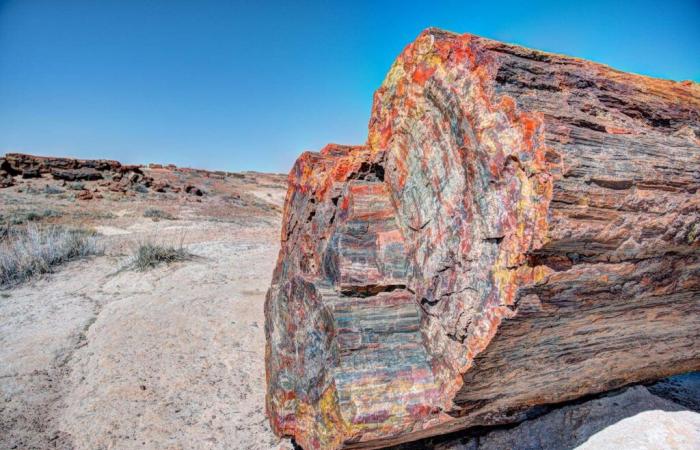The petrified forest of Arizona is certainly the best known to the general public, but there are many others around the world, notably on the island of Lesbos in Greece, in Sarmiento in Argentina and in Damaraland in Namibia. It’s difficult, when you walk in these national parks, to imagine that the trunks you see lying on the ground are several tens, or even hundreds of millions of years old!
The wood fibers are sometimes still clearly visible but upon closer inspection, you quickly realize that sticking an ax into them will be difficult! The wood has in fact completely transformed into stone.
The secret of petrified wood: avoiding the degradation of organic matter
This process of petrificationpetrification is a boon for paleontologistspaleontologistswho thus have access to numerous and precious details which make it possible to reconstruct the environment of a sometimes very distant past. Usually, the wood degrades very quickly when the plant dies. In question: the activity of microorganismsmicroorganisms and bacteriabacteria. Wood, like the rest of organic matter of plant or animal origin, is therefore particularly difficult to fossilize.
However, when certain very specific conditions are met, the trunks will not be decomposed. Gradually, the mattermatter organic will in fact be replaced by mineralsmineralswhich will allow the preservation of the structure of the wood: shape of the trunk, fibers, cells, etc. This process called petrification occurs when the wood finds itself buried quickly in an environment without oxygen, which will prevent its degradation.
The petrified forest of Jaramillo National Park in Argentina, which has more than 200 trunks – some up to 55 meters long – was preserved thanks to a volcanic eruption that occurred around 170 million years ago. The trees were quickly buried under a thick layer of ash. In other cases, it is an episode of flooding which would have carried away the trunks, covering them with clay sediments.
A substitution of organic matter by minerals at the very heart of cells
But for the petrification process to take place, another step is necessary. Water rich in minerals must indeed circulate in the environment, at least occasionally. Slowly, the minerals will crystallize within the wood cells themselves, replacing the organic matter. The final appearance of the petrified wood will therefore depend on the composition of the fluid circulating in its fibers. Most often, wood is replaced by silicate minerals (opal, chalcedony, quartz), but sometimes also by pyritepyrite. Over time, all the original organic material is replaced.
THE colorscolors sported by the petrified trunks come from metalsmetals which can be found in the form of traces in the fluids circulating in the sediments. THE ferferthe most common, will give a red color depending on its degree ofoxidationoxidation. The presence of chromium will, for its part, produce green tints.
Erosion and movementsmovements tectonics will eventually exhume the petrified trunks.






